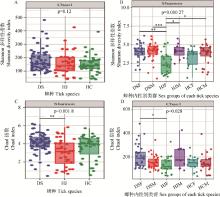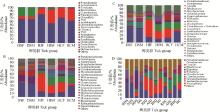





Acta Veterinaria et Zootechnica Sinica ›› 2025, Vol. 56 ›› Issue (6): 2927-2936.doi: 10.11843/j.issn.0366-6964.2025.06.035
• Preventive Veterinary Medicine • Previous Articles Next Articles
YIN Guolu( ), YU Tian, WANG Jinqi, XU Ying, LIU Zhe, GAO Xu, YU Longzheng, JI Shengwei, XUE Shujiang*(
), YU Tian, WANG Jinqi, XU Ying, LIU Zhe, GAO Xu, YU Longzheng, JI Shengwei, XUE Shujiang*( ), JIN Dongchun*(
), JIN Dongchun*( )
)
Received:2024-07-31
Online:2025-06-23
Published:2025-06-25
Contact:
XUE Shujiang, JIN Dongchun
E-mail:1454616295@qq.com;sjxue@ybu.edu.cn;jindongchun@ybu.edu.cn
CLC Number:
YIN Guolu, YU Tian, WANG Jinqi, XU Ying, LIU Zhe, GAO Xu, YU Longzheng, JI Shengwei, XUE Shujiang, JIN Dongchun. Molecular Epidemiology of Tick Borne Pathogens and Investigation of Tick Borne Microbiota in Some Cities and Counties in the Tumen River Basin[J]. Acta Veterinaria et Zootechnica Sinica, 2025, 56(6): 2927-2936.

Fig. 1
Microbial diversity and richness in samples A. Shannon diversity index of OTU level of three tick species; B. Shannon diversity index at the OTU level of sex groups within each tick species; C. Chao1 index of OTU level of three tick species; D. Chao1 index of OTU level of sex groups within each tick species; F. Female; M. Male; DS. Dermacentor silvarum; HJ. Haemaphysalis japonica; HC. Haemaphysalis conicinna. *.P < 0.05; **.P < 0.01; ***.P < 0.001"


Fig. 4
The abundance distribution of microbial flora at the phylum level A. The abundance distribution of microbial flora at the phylum level; B. The abundance distribution of microbial flora at the family level; C. The abundance distribution of microbial flora at the genus level; D. Distribution of microflora abundance values of ticks carrying different pathogens at the genus level (R. Ticks carrying spotted fever group rickettsiae; A. Ticks carrying Anaplasma; B. Ticks carrying babesiae); F. Female; M. Male; DS. Dermacentor silvarum; HJ. Haemaphysalis japonica; HC. Haemaphysalis conicinna"

| 1 |
陈玲, 陈浩, 岳婵娟, 等. 原核表达的褐黄血蜱唾液腺蛋白和铁蛋白1的免疫保护效果评价[J]. 畜牧兽医学报, 2024, 55 (2): 688- 697.
doi: 10.11843/j.issn.0366-6964.2024.02.026 |
|
CHEN L , CHEN H , YUE C J , et al. Evaluation of the immune protection effect of prokaryotic expressed salivary protein and ferritin1 in Haemaphysalis flava[J]. Acta Veterinaria et Zootechnica Sinica, 2024, 55 (2): 688- 697.
doi: 10.11843/j.issn.0366-6964.2024.02.026 |
|
| 2 |
陈施华, 张秋宇, 袁瑾, 等. 嗜吞噬细胞无形体致病机制的研究现状[J]. 中华微生物学和免疫学杂志, 2021, 41 (12): 962- 968.
doi: 10.3760/cma.j.cn112309-20210616-00205 |
|
CHEN S H , ZHANG Q Y , YUAN J , et al. Pathogenic mechanisms of Anaplasma phagocytophilum[J]. Chinese Journal of Microbiology and Immunology, 2021, 41 (12): 962- 968.
doi: 10.3760/cma.j.cn112309-20210616-00205 |
|
| 3 |
程天印, 吴聪颖, 刘雨珂, 等. 褐黄血蜱HSP70-b2及其类14-Mer肽的作用研究[J]. 畜牧兽医学报, 2023, 54 (6): 2570- 2580.
doi: 10.11843/j.issn.0366-6964.2023.06.034 |
|
CHENG T Y , WU C Y , LIU Y K , et al. Studies on the role of HSP70-b2 and its 14-mer-like peptide from Haemaphysalis flava[J]. Acta Veterinaria et Zootechnica Sinica, 2023, 54 (6): 2570- 2580.
doi: 10.11843/j.issn.0366-6964.2023.06.034 |
|
| 4 |
刘誉, 吴锦顺, 潘娟. 马巴贝斯虫病的检测技术研究进展[J]. 口岸卫生控制, 2023, 28 (5): 38- 43.
doi: 10.3969/j.issn.1008-5777.2023.05.009 |
|
LIU Y , WU J S , PAN J . Review of the detection technology for Babesia equi[J]. Port Health Control, 2023, 28 (5): 38- 43.
doi: 10.3969/j.issn.1008-5777.2023.05.009 |
|
| 5 |
BOCK R , JACKSON L , DE VOS A , et al. Babesiosis of cattle[J]. Parasitology, 2004, 129 (S1): S247- S269.
doi: 10.1017/S0031182004005190 |
| 6 |
FELDHAAR H . Bacterial symbionts as mediators of ecologically important traits of insect hosts[J]. Ecol Entomol, 2011, 36 (5): 533- 543.
doi: 10.1111/j.1365-2311.2011.01318.x |
| 7 |
QIU Y J , NAKAO R , OHNUMA A , et al. Microbial population analysis of the salivary glands of ticks; a possible strategy for the surveillance of bacterial pathogens[J]. PLoS One, 2014, 9 (8): e103961.
doi: 10.1371/journal.pone.0103961 |
| 8 | 邵明旭. 小尾寒羊肠道正常菌群高通量测序分析及羊源微生态制剂的研制[D]. 泰安: 山东农业大学, 2016. |
| SHAO M X. High-throughput sequencing analysis of normal intestinal flora in small tail han sheep and the development of sheep source probiotics[D]. Taian: Shandong Agricultural University, 2016. (in Chinese) | |
| 9 |
THAPA S , ZHANG Y , ALLEN M S . Bacterial microbiomes of Ixodes scapularis ticks collected from Massachusetts and Texas, USA[J]. BMC Microbiol, 2019, 19 (1): 138.
doi: 10.1186/s12866-019-1514-7 |
| 10 |
KURILSHIKOV A , LIVANOVA N N , FOMENKO N V , et al. Comparative metagenomic profiling of symbiotic bacterial communities associated with Ixodes persulcatus, ixodes pavlovskyi and dermacentor reticulatus ticks[J]. PLoS One, 2015, 10 (7): e0131413.
doi: 10.1371/journal.pone.0131413 |
| 11 |
SPERLING J L , SILVA-BRANDÃO K L , BRANDÃO M M , et al. Comparison of bacterial 16S rRNA variable regions for microbiome surveys of ticks[J]. Ticks Tick Borne Dis, 2017, 8 (4): 453- 461.
doi: 10.1016/j.ttbdis.2017.02.002 |
| 12 |
郭銮英, 王妮娜, 李杭远, 等. 蜱携带牛丙型肝炎病毒新亚型巢式PCR检测方法的建立[J]. 畜牧兽医学报, 2022, 53 (3): 972- 977.
doi: 10.11843/j.issn.0366-6964.2022.03.030 |
|
GUO L Y , WANG N N , LI H Y , et al. The development of nested PCR assay for new subtype of bovine hepacivirus in ticks[J]. Acta Veterinaria et Zootechnica Sinica, 2022, 53 (3): 972- 977.
doi: 10.11843/j.issn.0366-6964.2022.03.030 |
|
| 13 |
BINETRUY F , DUPRAZ M , BUYSSE M , et al. Surface sterilization methods impact measures of internal microbial diversity in ticks[J]. Parasit Vectors, 2019, 12 (1): 268.
doi: 10.1186/s13071-019-3517-5 |
| 14 | 于昕宇. 牡丹江地区反刍动物携带主要蜱传病原的分子流行病学调查[D]. 大庆: 黑龙江八一农垦大学, 2021. |
| YU X Y. Molecular epidemiological investigation of major tick-borne pathogens carried by ruminants in the Mudanjiang[D]. Daqing: Heilongjiang Bayi Agricultural University, 2021. (in Chinese) | |
| 15 | CASATI S, SAGER H, GERN L, et al. Presence of potentially pathogenic Babesia sp. for human in Ixodes ricinus in Switzerland[J]. Ann Agric Environ Med, 2006, 13(1): 65-70. |
| 16 |
PANETTA J L , ŠÍMA R , CALVANI N E D , et al. Reptile-associated Borrelia species in the goanna tick (Bothriocroton undatum) from Sydney, Australia[J]. Parasit Vectors, 2017, 10 (1): 616.
doi: 10.1186/s13071-017-2579-5 |
| 17 |
TIAN Z X , LIU G Y , SHEN H , et al. First report on the occurrence of Rickettsia slovaca and Rickettsia raoultii in Dermacentor silvarum in China[J]. Parasit Vectors, 2012, 5, 19.
doi: 10.1186/1756-3305-5-19 |
| 18 | 卢志宇. 我国部分地区硬蜱携带立克次体的分子鉴定[D]. 北京: 军事科学院, 2021. |
| LU Z Y. Molecular identification of Rickettsia in hard ticks in some regions of China[D]. Beijing: Academy of Military Sciences, 2021. (in Chinese) | |
| 19 | 王亚伟. 我国北方地区家畜和媒介蜱携带新型无形体的调查[D]. 北京: 中国人民解放军军事医学科学院, 2016. |
| WANG Y W. Investigations on novel Anaplasma infections in livestock and ticks from northern China[D]. Beijing: Academy of Military Medical Sciences, 2016. (in Chinese) | |
| 20 | 韩悦. 吉林省部分地区羊泰勒虫病与嗜吞噬细胞无形体病的分子流行病学调查[D]. 延吉: 延边大学, 2022. |
| HAN Y. Molecular epidemiological investigation of Ovine theileriasis and Phagocytophilum anaplasmosis in cattle in Jilin Province[D]. Yanji: Yanbian University, 2022. (in Chinese) | |
| 21 | 耿亚娜. 延边地区马驽巴贝斯虫病的分子流行病学调查与进化分析[D]. 延吉: 延边大学, 2016. |
| GENG Y N. Molecular epidemiology investigation and evolutionary analysis of horseback babes insects in Yanbian[D]. Yanji: Yanbian University, 2016. (in Chinese) | |
| 22 |
ADEGOKE A , KUMAR D , BUDACHETRI K , et al. Hematophagy and tick-borne Rickettsial pathogen shape the microbial community structure and predicted functions within the tick vector, Amblyomma maculatum[J]. Front Cell Infect Microbiol, 2022, 12, 1037387.
doi: 10.3389/fcimb.2022.1037387 |
| 23 |
ZOLNIK C P , PRILL R J , FALCO R C , et al. Microbiome changes through ontogeny of a tick pathogen vector[J]. Mol Ecol, 2016, 25 (19): 4963- 4977.
doi: 10.1111/mec.13832 |
| [1] | ZHAO Wanyue, XU Xiaowen, CHANG Shushu, XIANG Zhijie, GUO Aizhen, CHEN Yingyu. Epidemiologic Investigation of the Major Viruses of the Bovine Respiratory Disease Complex [J]. Acta Veterinaria et Zootechnica Sinica, 2025, 56(3): 1324-1335. |
| [2] | FAN Jie, TAI Yirun, ZHU Yanli, CHEN Zhixiong, HU Qiaoyun, CHEN Zhi, LIU Tiantian, LI Xin, FAN Zhongxin, GE Meng. Investigation of Porcine Circovirus 2 Infection Status and Analysis of Genetic Evolution in Hunan Province in Recent Years [J]. Acta Veterinaria et Zootechnica Sinica, 2025, 56(3): 1376-1385. |
| [3] | Sihan ZHOU, Tianen LI, Jinhua DENG, Hongchao SUN, Wenchao YAN, Tuanyuan SHI, Tianqi WANG. Investigation and Analysis on Infection of Chicken Coccidia in Some Regions of Zhejiang Province [J]. Acta Veterinaria et Zootechnica Sinica, 2024, 55(6): 2629-2640. |
| [4] | LI Siyuan, FU Xincheng, YUAN Xuesong, MAO Li, CAI Xuhang, SUN Xinru, HUANG Jin, XIE Lingling, WANG Fu, ZHOU Hua, ZHANG Qi, LI Jizong, LI Bin. Detection of Bovine Viral Diarrhea Pathogens and Evolution Analysis of Bovine Coronavirus in Langfang, Hebei [J]. Acta Veterinaria et Zootechnica Sinica, 2024, 55(2): 649-659. |
| [5] | HE Shufan, ZOU Yuantong, HUANG Zhilan, LI Qian, JIANGCUO Wengxi, YUE Hua, TANG Cheng, LIU Jie. Detection of Bovine Adenovirus Type 3 Infection Status and Its Fiber Shaft Gene [J]. Acta Veterinaria et Zootechnica Sinica, 2023, 54(3): 1333-1340. |
| [6] | SUN Feiyan, YE Jingfei, WEI Yu, WANG Zixian, ZHANG Jinyu, BING Liyuan, MENG Tingting, WANG Shuai, ZHAO Lifeng, SUN Liang, GUO Li. Epidemiological Investigation and Analysis of Bovine Coronavirus in Beef Cattle in Jilin Province [J]. Acta Veterinaria et Zootechnica Sinica, 2023, 54(2): 673-682. |
| [7] | HU Yue, GAO Yanni, Jarhen, CHE Chuanzhong, WANG Xulei, JIANG Ping, RAN Duoliang, LIU Jianhua. Serological Investigation of Equid Herpesvirus-1 Infection in Some Areas of Xinjiang [J]. Acta Veterinaria et Zootechnica Sinica, 2021, 52(3): 845-850. |
| [8] | ZHANG Yanhong, LI Yan, YANG Yan, ZHANG Zhe, LÜ Wenhua, QIAN Tianhao, MENG Yaqi, SHENG Jinliang. Serological Investigation of Maedi-Visna Virus Infection in Some Areas of Xinjiang [J]. Acta Veterinaria et Zootechnica Sinica, 2020, 51(8): 2022-2026. |
| [9] | HE Xiutian, XIANG Yang, YUAN Dongbo, YANG Aiguo, FAN Xiaohu, TAN Xiong, ZHONG Yeqing, HAO Lili. PCR Detection and Phylogenetic Analysis of Bartonella spp. and Anaplasma spp. in Ixodid Ticks Collected from Yak and Plateau Pika in Songpan County of Sichuan Province [J]. Acta Veterinaria et Zootechnica Sinica, 2020, 51(6): 1438-1446. |
| [10] | YANG Zhenxing, ZHU Pei, LI Zhanhong, LIAO Defang, ZHU Jianbo, XIAO Lei, XIE Jiarui, LI Huachun, YANG Heng. Serological Investigation of Chuzan Disease of Cattle, Goat and Sheep in China [J]. ACTA VETERINARIA ET ZOOTECHNICA SINICA, 2019, 50(8): 1715-1722. |
| [11] | ZHANG Ruo-xi, ZHANG Zhi, GU Wen-yuan, LIU Tian-ju, LI Chong, WANG Jian-chang, LI Bin, YUAN Wan-zhe, WANG Yu-qing, HAN Qing-an. Detection of Porcine Diarrhea Associated Virus and Genetic Variation Analysis of S Gene of Porcine Epidemic Diarrhea Virus in Hebei Province [J]. ACTA VETERINARIA ET ZOOTECHNICA SINICA, 2018, 49(3): 597-605. |
| [12] | CHEN Xin-nuo, XIAO Min, RUAN Wen-qiang, QIN Si-nan, YUE Hua, TANG Cheng, ZHANG Bin. Molecular Epidemiological Investigation and Isolation of Bovine Viral Diarrhea Virus in Yak in Sichuan-Tibet Plateau Region [J]. ACTA VETERINARIA ET ZOOTECHNICA SINICA, 2018, 49(3): 606-613. |
| [13] | LIU Yang,WANG Chuan-bin,HUO Si-qi,ZHAI Xin-yan,XIN Sheng-peng,LIU Yu-liang,HAN Xue,ZHANG Qian,YANG Wei-zheng,GU Xiao-xue. Epidemiologic Investigation of Four Viruses Carried by Ducks and Geese in China [J]. ACTA VETERINARIA ET ZOOTECHNICA SINICA, 2016, 47(8): 1610-1617. |
| [14] | YOU Yong-jun,ZHANG Guo-zhong,LIU Yue-huan,WANG You,LIANG Wu,LIU Xing-cai,SHEN Yuan. The Epidemiological Investigation of the Chicken Infectious Bronchitis in China between 2010 and 2012 [J]. ACTA VETERINARIA ET ZOOTECHNICA SINICA, 2015, 46(2): 264-272. |
| [15] | DING Ke,YU Zu-hua,PENG Chun-ping,ZHAO Zhan-qin,HE Lei,JIA Yan-yan,ZHANG Chun-jie,CHENG Xiang-chao,XIA Xian-zhu. Molecular Epidemiological Investigation of Canine Parvovirus Isolates from Henan Province during 2011-2013 [J]. ACTA VETERINARIA ET ZOOTECHNICA SINICA, 2014, 45(10): 1671-1678. |
| Viewed | ||||||
|
Full text |
|
|||||
|
Abstract |
|
|||||